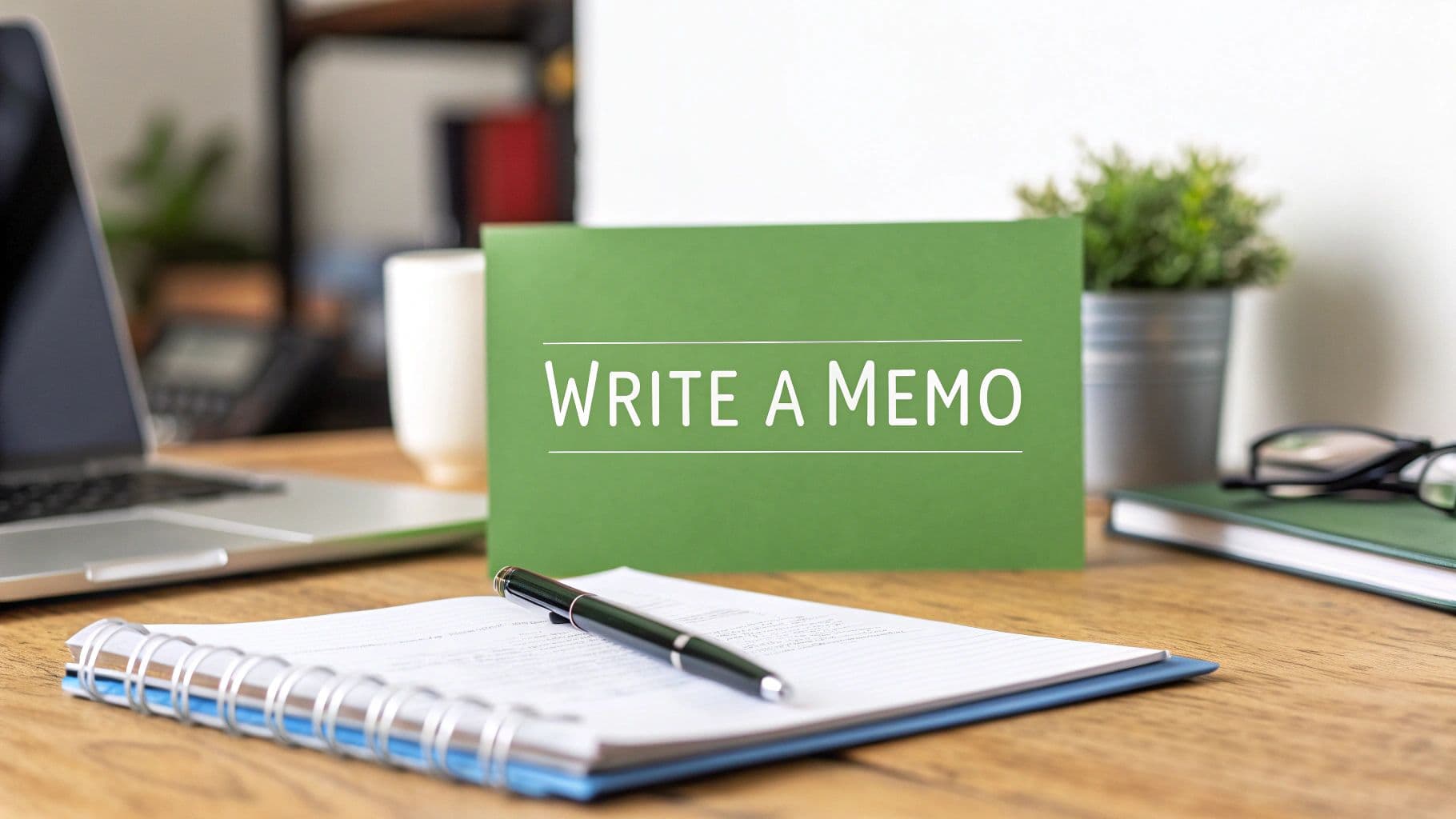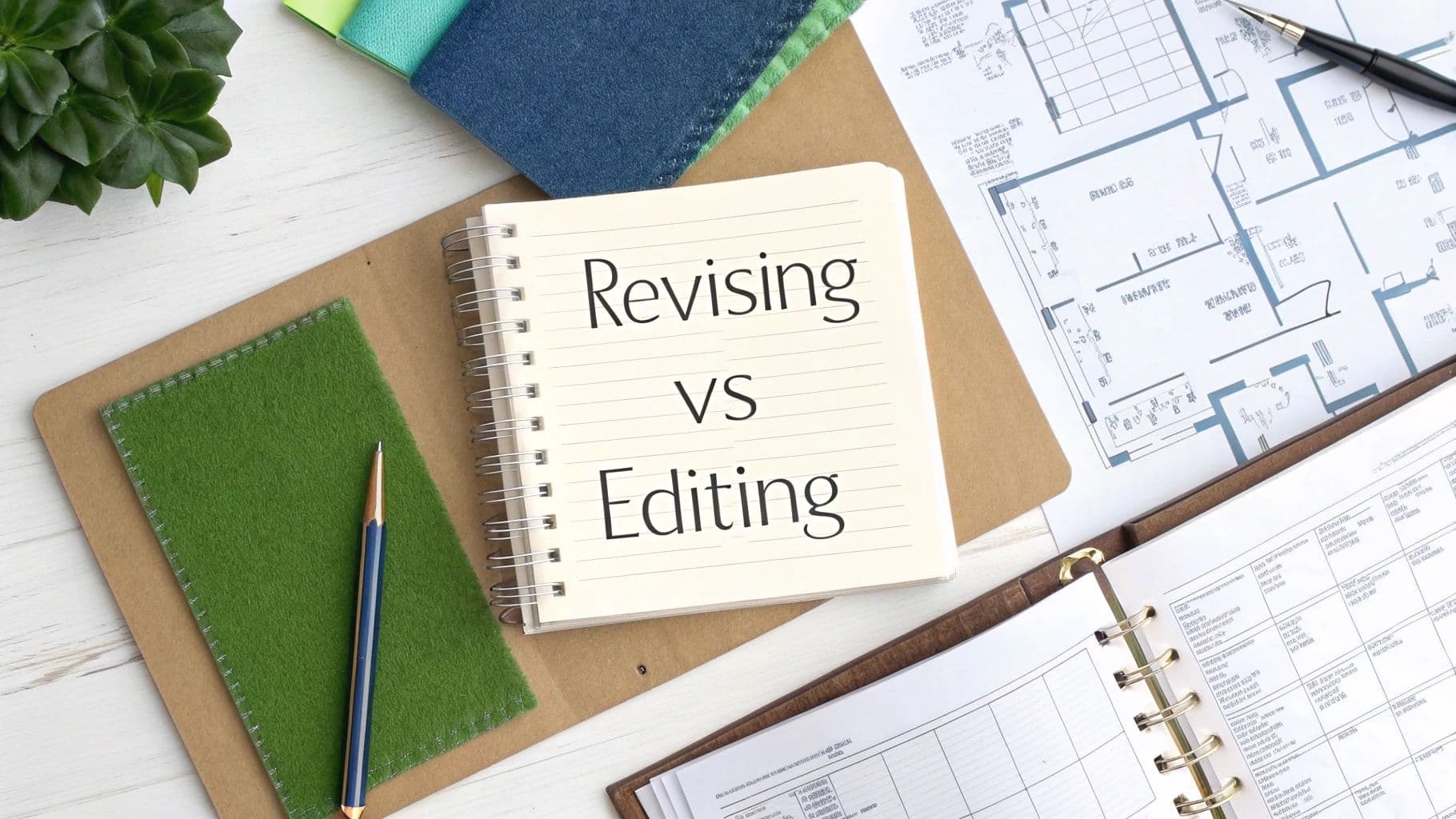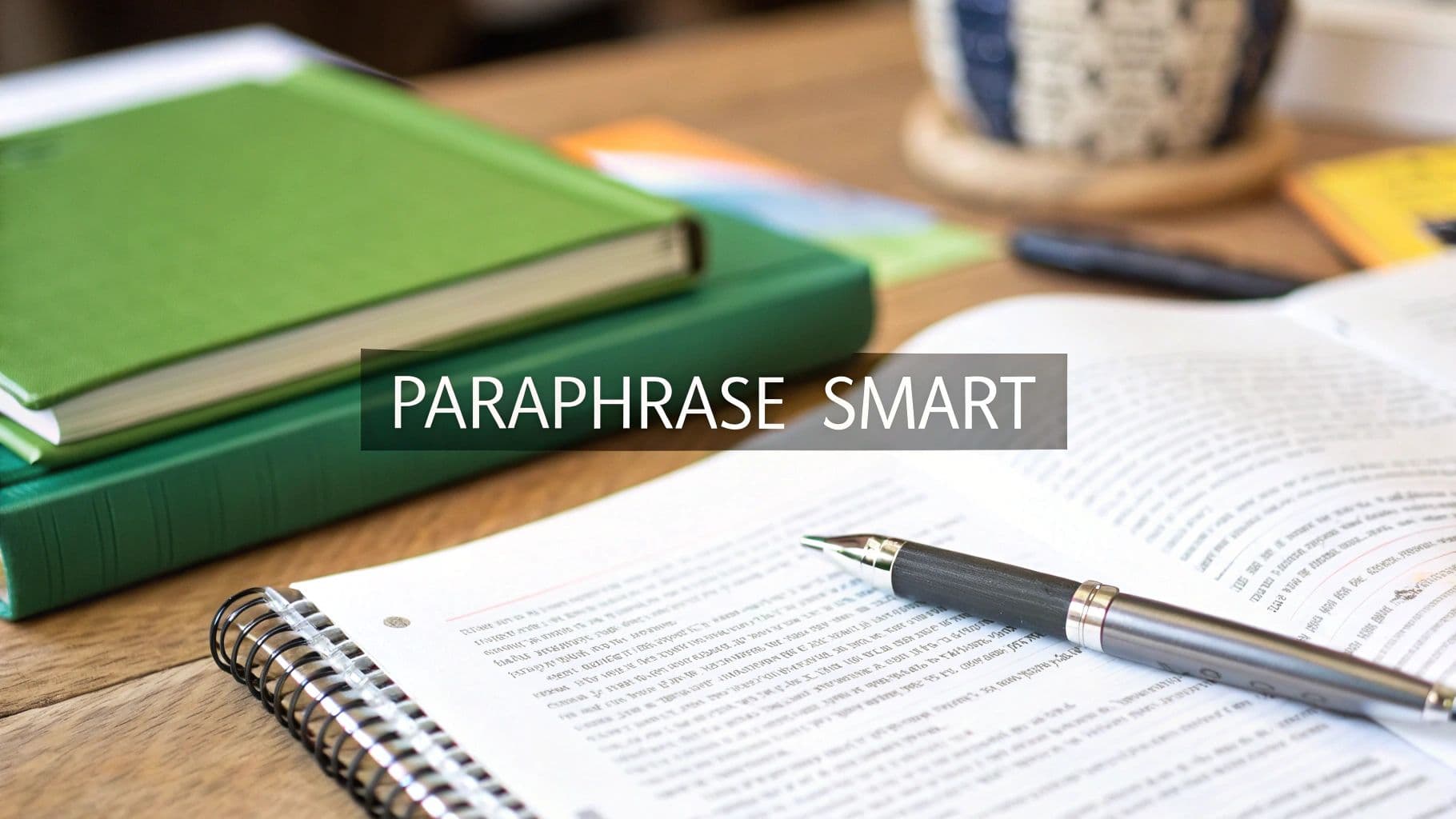
How to Paraphrase a Paragraph and Avoid Plagiarism
November 6, 2025
Learning how to paraphrase a paragraph is about more than just swapping out a few words. It's about capturing an idea and explaining it in your own unique voice. The best way I’ve found to do this is to read the text until you get the core message, then set it aside and explain the concept from memory.
The Foundation of Effective Paraphrasing
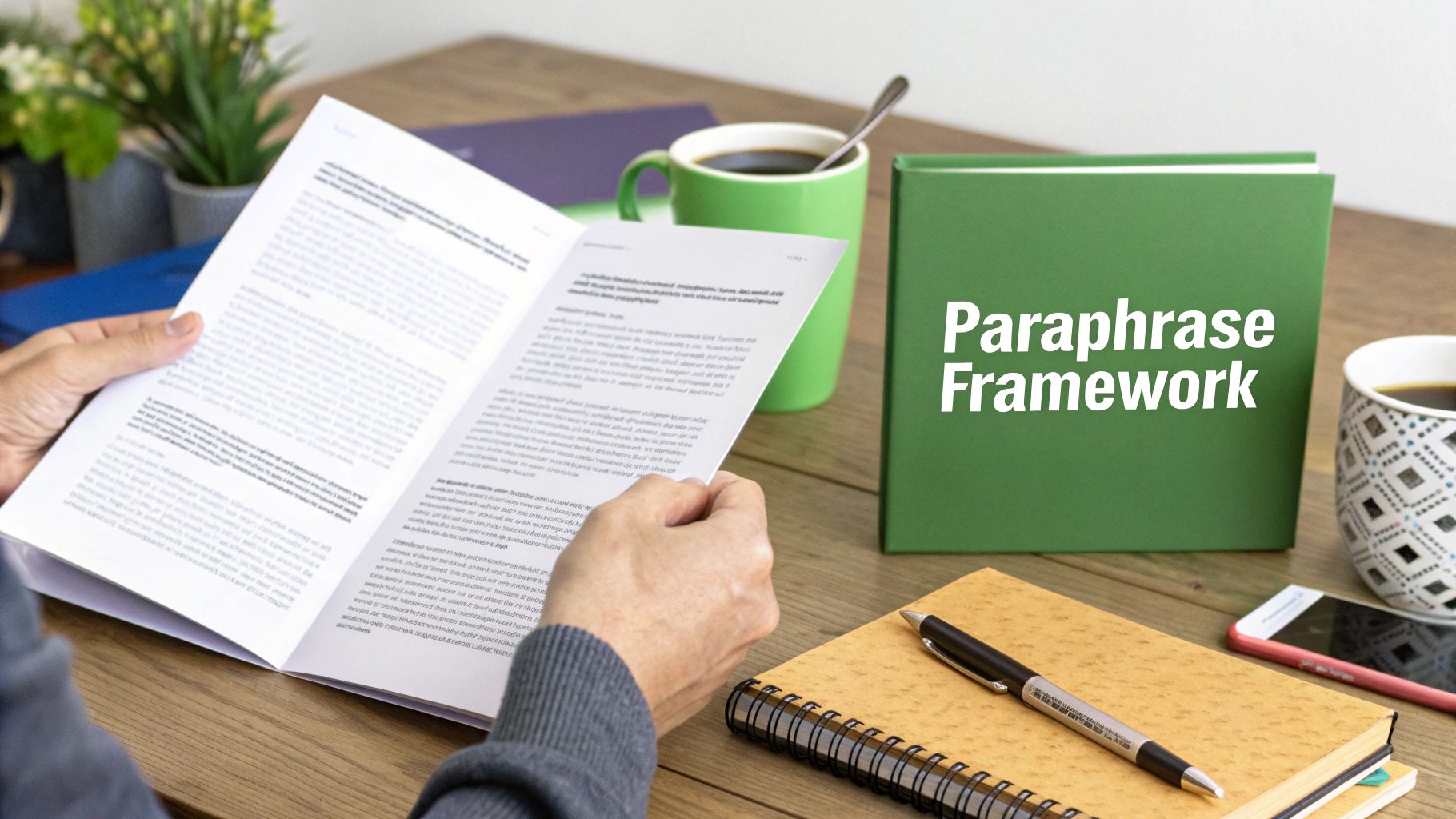
Before you change a single word, you have to understand what you're actually trying to do. Good paraphrasing is a sign of comprehension, not just a thesaurus workout. It's a crucial skill for weaving source material into your own work, whether you're writing a research paper, a blog post, or a business report.
This isn’t complicated, but it does require a bit of thought. Real paraphrasing is an active process that forces you to dig deeper into the source material. By internalizing the information and then rebuilding it in your own style, you make the idea yours while still giving proper credit where it's due.
A 4-Step Framework for Paraphrasing
I think of this as a four-part mental checklist I run through every single time I work with a source. Mastering this sequence is what builds a solid foundation for ethical and clear writing.
- Read for Understanding: First, read the original paragraph a couple of times. The goal isn't to memorize the exact words but to fully grasp the main argument and its supporting points.
- Pull Out the Key Concepts: Next, pinpoint the main ideas. What's the author's primary claim? What evidence do they use to back it up? Jot these down in a few quick bullet points.
- Draft from Memory: Now, hide the original text. Seriously, put it away. Using only your notes, write a new paragraph that explains the concepts in your own words and sentence structure.
- Compare and Cite: Finally, bring back the original text. Compare your version to the source to make sure you've kept the original meaning without borrowing specific phrases or sentence patterns. Then, add your citation.
The ultimate goal is to blend an external idea into your narrative so smoothly that it feels like it belongs. A great paraphrase adds value and credibility without breaking the flow of your writing.
This methodical approach is your best defense against unintentional plagiarism while ensuring your work is accurate.
A Quick Guide to Ethical Paraphrasing
To keep things simple, here’s a quick table summarizing the core actions for paraphrasing a paragraph the right way.
| Action | What It Looks Like | Why It's Crucial |
|---|---|---|
| Understand First | Reading the source until you can explain it to someone else without looking at it. | Prevents you from just mindlessly swapping words and helps you retain the original meaning. |
| Rewrite in Your Voice | Using completely different sentence structures and your own vocabulary to convey the idea. | This is the very definition of paraphrasing and demonstrates your own command of the material. |
| Check for Accuracy | Comparing your paraphrase back to the original to ensure the core message hasn't been twisted. | Maintains the integrity of the original author's idea and prevents misinformation. |
| Always Give Credit | Adding an in-text citation (e.g., APA, MLA) that points the reader back to the source. | This is non-negotiable for avoiding plagiarism and acknowledging the work of others. |
Following these steps builds good writing habits and protects your credibility. For a deeper dive, our guide on how to avoid plagiarism offers even more strategies.
Proven Techniques for Paraphrasing Any Text
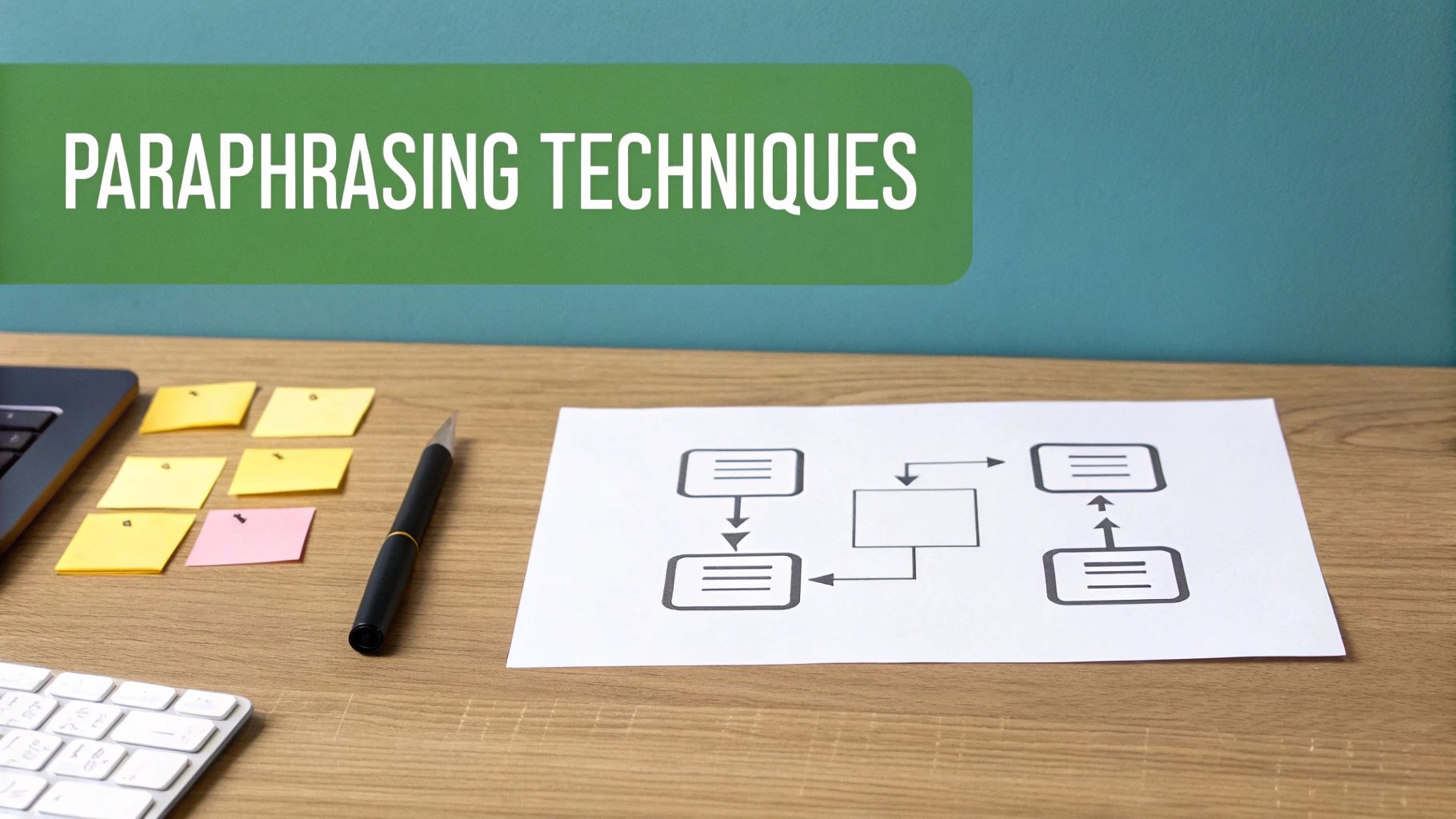
This little snippet from Wikipedia gets right to the heart of paraphrasing. It wasn't invented to get around plagiarism checkers; it started as a way to show you truly understood an idea.
But knowing what it is and knowing how to do it are two different things. Truly effective paraphrasing is more than just shuffling a few words around. It’s about taking an idea, digesting it, and then explaining it in your own voice, all while giving credit where it's due.
Let's get into some hands-on methods you can use right away. Think of these less as rigid rules and more as flexible tools. The real magic happens when you start combining them.
Start by Changing the Sentence Structure
One of the best ways to break away from the original text is to mess with its structure. Don't just paint by numbers using the author's original sentence layout.
- Flip from Active to Passive: Take a sentence like, "The researcher conducted the study." You can instantly change its feel by writing, "The study was conducted by the researcher." It’s a simple shift, but it changes the entire rhythm.
- Combine and Conquer (or Divide): Got two short, choppy sentences? See if you can weave them into a single, more sophisticated one. On the flip side, if you're facing a long, winding sentence, break it into two or three punchier statements. It often makes the point much clearer.
Getting the structure right is the first big step. If you want to dive deeper into this, we cover more advanced methods in our guide to paraphrasing techniques.
Find Your Own Words
Once the structure feels different, it's time to work on the language. This is where a lot of people go wrong by just right-clicking for synonyms. That's a fast track to awkward, unnatural-sounding text.
Instead, ask yourself: "How would I explain this to a friend over coffee?" Use words that are actually in your vocabulary and fit the new sentences you've built.
The goal is to translate the core idea, not just swap out a few words. You’re moving the concept from the author's voice into yours.
This focus on genuine rephrasing is what separates a weak paraphrase from a strong one.
Try the "Chunking" Method
For those really dense paragraphs, the "chunking method" is a game-changer. It forces you to deconstruct the original text into its core ideas, or "chunks," before you even think about writing.
Here’s how it works:
- Read the paragraph and pull out the main points. What is it really saying?
- Jot these "chunks" down as simple bullet points.
- Now, rearrange those bullets into a new order that flows well for your own article.
- Finally, write your new paragraph based on your reordered list, using your own words.
This approach makes it almost impossible to just mirror the original. It forces you to internalize the information first.
It's a skill that's becoming more critical every day. With the explosion of digital content, the paraphrasing tool market was valued at USD 1.15 billion and is projected to hit USD 3.87 billion by 2035, driven by the constant need for fresh, unique content. You can see the full breakdown in this market research report.
Common Paraphrasing Mistakes You Might Be Making

Even when you're trying your best, it’s surprisingly easy to fall into a few common traps. The result? Accidental plagiarism or writing that just sounds clunky and unnatural. Knowing what these pitfalls look like is the first step toward paraphrasing like a pro.
One of the most frequent slip-ups is patchwriting. This is where you take the original text and just swap out a few words with synonyms while keeping the sentence structure exactly the same. Think of it as a flimsy disguise—plagiarism checkers can often see right through it, and it doesn't show you've truly grasped the material.
Another classic mistake is going wild with a thesaurus without paying attention to context. Sure, you can swap "important" for "momentous," but words carry different weights and shades of meaning. Forcing in a synonym can create awkward phrasing and completely miss the author's original point.
The Single Biggest Paraphrasing Mistake
Here's the thing: the most critical error you can make has nothing to do with the words you choose.
It’s failing to cite your source.
Even a perfectly rephrased paragraph is still considered plagiarism if you present someone else's idea as your own. Proper attribution isn't just good practice; it's non-negotiable.
So, how do you steer clear of these issues? Focus on these three habits:
- Tackle the structure first. Before you even think about synonyms, rearrange the clauses. Combine a few short sentences into one, or break up a long one.
- Explain it from memory. After reading the source, put it away and try to explain the main idea out loud or on a blank document. This forces you to use your own language patterns.
- Always, always cite. When in doubt, add that citation. It protects your credibility and gives credit where it's due.
A great paraphrase doesn’t just reword a sentence; it re-engineers the entire structure to deliver the same core message in a completely new way. It's about rebuilding, not just redecorating.
To make this crystal clear, let's look at how these common errors show up in the real world and, more importantly, how to fix them.
Identifying and Fixing Common Paraphrasing Errors
This table breaks down the most frequent mistakes side-by-side with strategies to correct them effectively.
| Common Mistake | Example of the Error | How to Fix It |
|---|---|---|
| Patchwriting | The study found significant results that were vital for the research. | The research produced crucial findings that proved to be significant. |
| Forgetting to Cite | Market trends indicate a strong consumer shift toward sustainable products. | Market trends indicate a strong consumer shift toward sustainable products (Source, 2023). |
Spotting these patterns in your own writing is half the battle. Once you know what to look for, you can start building better habits that lead to clear, ethical, and original work.
Using AI Paraphrasing Tools Responsibly
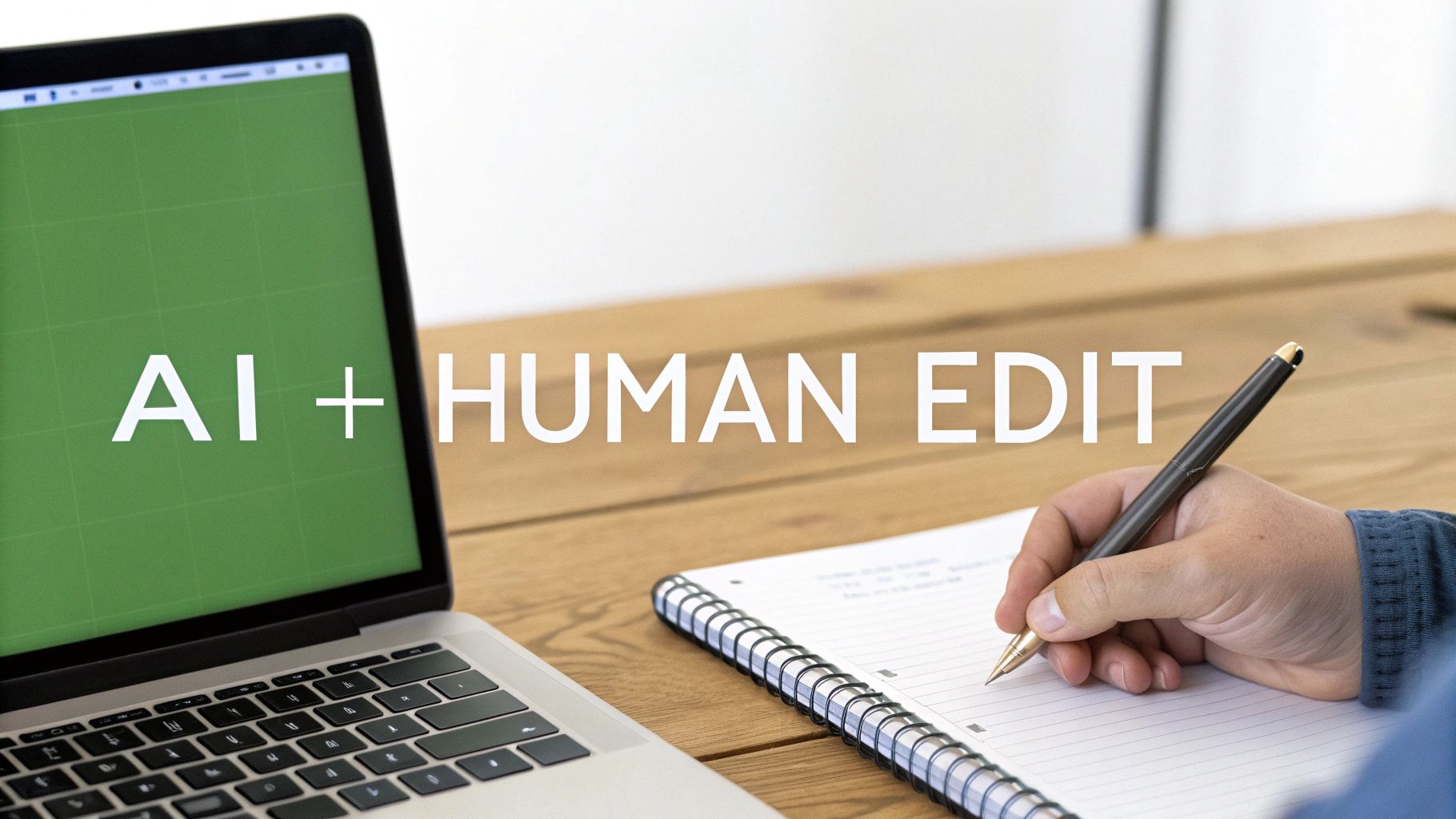
Let's be clear: AI paraphrasing tools can be a fantastic ally. They're great for breaking through writer's block or just seeing an idea from a different angle. But they are absolutely not a replacement for your own brain.
The biggest mistake you can make is blindly trusting whatever the AI spits out. We’ve all seen it—text that sounds robotic, misses the point entirely, or worse, introduces flat-out wrong information. The trick is to treat these tools like a brainstorming partner, not the final author.
A Human-in-the-Loop Workflow
The smartest way to work with AI is by keeping a human in the loop. That's you. You're always in control, using the AI to assist your thinking, not replace it.
Here’s a simple workflow that actually works:
- Generate Ideas: Let the tool give you a first pass or a few different ways to structure a sentence. Think of it as a rough sketch.
- Edit and Refine: This is where you come in. Go through the AI's output with a fine-tooth comb. Fix the tone, inject your own voice, and check every single detail for accuracy.
- Fact-Check Everything: Never, ever assume the AI is telling the truth. Always go back to the original source to verify any facts, figures, or claims.
This balanced approach is becoming standard practice. The market for these tools is expected to hit USD 4.8 billion by 2032, which tells you just how many people are weaving them into their daily work.
Think of the AI's output as raw clay. It’s your job as the writer to sculpt it into something accurate, coherent, and genuinely communicative.
And on a practical note, part of using AI responsibly is understanding AI tool privacy policies to see how your data is being used.
Ultimately, learning how to paraphrase a paragraph is about sharpening your own thinking and writing skills. For a deeper dive, our guide on ChatGPT paraphrasing has some great best practices.
Why Paraphrasing Is a Critical Professional Skill
Paraphrasing isn't just an academic exercise to get you through a term paper. Think of it as a professional power tool. Learning how to rephrase a paragraph well translates directly into efficiency and clarity, no matter what your job is. It helps you stand out as a sharp thinker and an effective communicator.
Take content marketing, for example. It's the engine that lets you create fresh blog posts and social media updates from existing research without getting hit with a duplicate content penalty. Your ability to restate insights in a unique way is foundational to strong SEO.
It's the same in any business setting. You can take a dense, jargon-filled report or rambling meeting notes and distill them into clear, actionable takeaways for your team. This moves projects forward faster and gets everyone on the same page. Simple, right?
Connecting Paraphrasing to Business Growth
The demand for original digital content has never been higher, making this skill incredibly valuable. In North America alone, the market for AI content paraphrasing tools hit USD 0.068 billion, commanding 40% of the global share. This boom is driven by one thing: the relentless need for quality content marketing and SEO. You can dig into more data on AI content paraphrasing market trends here.
Mastering paraphrasing isn't just about avoiding plagiarism; it's about becoming a better translator of ideas. You learn to take complex information and make it accessible, relevant, and valuable to your specific audience.
This skill is a genuine career accelerator. When you get good at it, you can:
- Communicate with precision: Boil down client feedback or complex data into clear, concise points that everyone understands.
- Create compelling content: Turn one solid piece of research into multiple unique assets for different platforms, stretching your efforts further.
- Increase your value: Become the go-to person who can cut through the noise, distill information, and drive real understanding across the organization.
Ultimately, strong paraphrasing skills make you a more versatile and impactful professional. It’s a core competency for anyone who works with information in today's world.
Your Paraphrasing Questions, Answered
When you're first getting the hang of paraphrasing, a few questions always seem to pop up. Here are the quick answers you're looking for.
Is Paraphrasing Just a Fancy Word for Summarizing?
Not at all. Think of it this way: paraphrasing is like explaining a single, specific idea in your own words, keeping it about the same length.
Summarizing is different. It’s about boiling down an entire article or a huge chunk of text to just its core points, making it much shorter.
How Many Words Do I Actually Have to Change?
This is a classic trap. People get caught up trying to hit a certain percentage, but there's no magic number.
Instead of counting words, focus on rebuilding the sentence structure from the ground up. If you tear the sentence down and reconstruct it, the right words will follow naturally. You'll end up with something that's truly yours.
Good paraphrasing isn't just swapping out a few words here and there. It's a complete teardown. The goal is to grab the core idea, then explain it like you're telling a friend what you just learned. That's how you make it sound like you.
Do I Still Need to Cite a Paraphrase?
Yes. Absolutely. Every single time.
Even if you’ve changed every word, the original idea, the research, or the argument still belongs to someone else. Skipping the citation is plagiarism, plain and simple. Proper credit is non-negotiable if you want to maintain your integrity.
Ready to turn your AI drafts into something that sounds genuinely human? Natural Write instantly refines your text to sail past AI detectors and connect with readers. Give it a try for free at https://naturalwrite.com.

